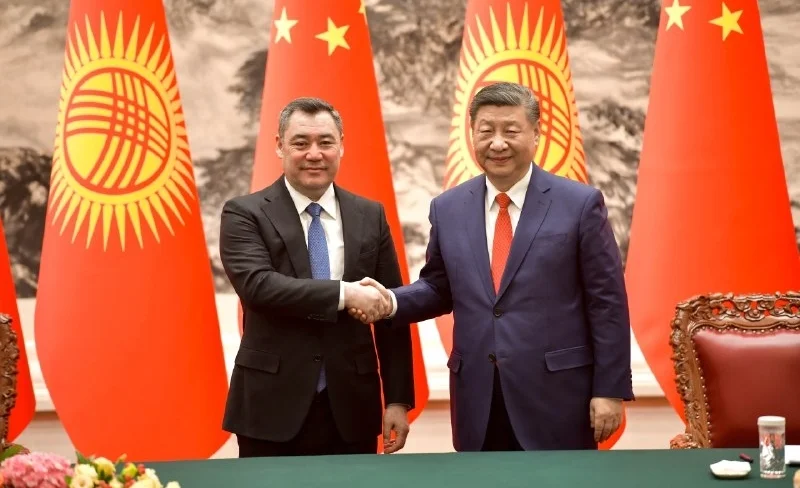CGTN journalist Pan Deng wrote for Kabar
The meeting between Chinese President Xi Jinping and Kyrgyz President Sadyr Zhaparov in Beijing on February 5, 2025, marks a pivotal moment in the evolution of bilateral relations. Against the backdrop of accelerating global and regional recalibrations, the two nations solidified their commitment to a "comprehensive strategic partnership for a new era," a relationship built on mutual trust, economic connectivity, and shared aspirations for common prosperity. This meeting culminated in a joint statement that not only reaffirmed the deep-rooted ties between the two sides but also outlined a comprehensive roadmap for enhanced strategic synergy and pragmatic cooperation across various sectors.
Strategic Synergy: The Basis of Deepening Ties
In his meeting with President Zhaparov, Chinese President Xi Jinping says China supports Kyrgyzstan in pursuing a development path suited to its national conditions and stands ready to work with Kyrgyzstan to further align development strategies and expand experience-sharing in state governance. President Zhaparov has lauded the longstanding exchanges between the two countries, noting China is a reliable friend and partner of Kyrgyzstan.
The joint statement issued after the two leaders’ meeting is a blueprint based on strategic synergy and shared vision, reflecting the evolving dynamics and deepening trust between the two nations.
The two sides emphasize that high-level exchanges are of great significance to the development of relations. China and Kyrgyzstan will maintain the positive momentum of high-level exchanges, further strengthen exchanges and cooperation between the central and local governments, legislatures and political parties, enhance policy communication, and deepen exchanges of experience in state governance.
The two sides highly value the fruitful achievements of jointly building the Belt and Road and will push forward the stronger synergy between the Belt and Road Initiative and Kyrgyzstan's National Development Program until 2026. High-quality cooperation is expected in the fields of economy and trade, investment, connectivity and scientific and technological innovation.
The joint statement’s focus on sectors such as trade in services, digital trade and green energy is indicative of a forward-looking agenda. It acknowledges the imperatives of the global economy and the necessity for both nations to be at the forefront of technological advancements. More agreements have also been signed to ensure that economic growth translates into tangible benefits for the general public.
China and Kyrgyzstan’s emphasis on aligning development strategies underscores a deepened understanding that sustainable progress is achievable through synchronized efforts. In essence, this document is more than a diplomatic formality; it is a strategic manifesto. It encapsulates a shared vision for the future, rooted in mutual respect, common goals, and a commitment to collaborative progress.
The CKU Railway: A New Chapter in Regional Connectivity
The joint statement has highlighted the importance of the China-Kyrgyzstan-Uzbekistan Railway for regional connectivity. The launch of the project in December 2024 is of great significance for the three countries to build a new artery for economic development.
Once completed, this railway is poised to open a new Eurasian corridor. The link not only carries strategic significance in boosting local trade, economic and industrial development, but also in facilitating the deeper integration of Central Asia as a whole and further elevating the region's influence on the global economy and supply chain.
By providing a more direct route for the transportation of goods, the CKU railway is expected to reduce transit time and costs, thereby bolstering trade efficiency. It can also help promote personnel exchanges and cultural ties, build a bridge for mutual learning among civilizations, and benefit countries and peoples in the region.
People-to-People Bonds: Bridging Minds and Cultures
Beyond economic and strategic considerations, the joint statement emphasizes enhancing people-to-people exchanges. The two countries have witnessed growing momentum in the fields of education and culture. China and Kyrgyzstan have organized cultural days for each other on many occasions. China has established four Confucius Institutes in Kyrgyzstan, with 21 Confucius Classrooms. Local exchanges between China and Kyrgyzstan are active. 28 pairs of friendly provinces and cities have been established.
Looking ahead, the two sides will deepen cooperation in the fields of radio, television and netcasting, and actively support the development of radio and television policy exchanges, mutual broadcasting of programs, personnel training and technology, as well as support the translation and publication of classic works, so as to enhance the mutual understanding and friendship between the two peoples.
More exchanges are also expected in cooperation between scientific research institutes, universities and enterprises in the fields of modern agriculture, industrial technology, biomedicine, green economy, environmental governance and seismology.
Cultural diplomacy, educational collaborations, and tourism are seen as vital avenues to foster mutual understanding and strengthen the social fabric between the two sides. Such exchanges are instrumental in building trust, dispelling misconceptions, and nurturing a sense of shared future among the peoples.
Conclusion
The latest meeting between Presidents Xi Jinping and Sadyr Zhaparov sets a new milestone in China-Kyrgyzstan relations. The comprehensive agreements and strategic initiatives outlined are poised to usher in a new era of collaboration, characterized by deepened economic ties, enhanced connectivity, and robust people-to-people interactions. As these plans transition into action, the partnership between China and Kyrgyzstan is set to become a model of bilateral cooperation in the region, contributing significantly to regional stability and prosperity.
